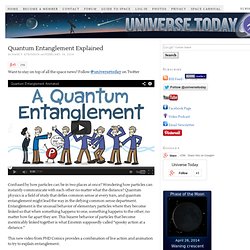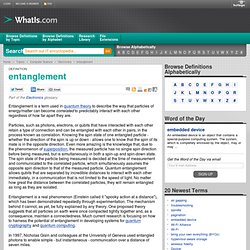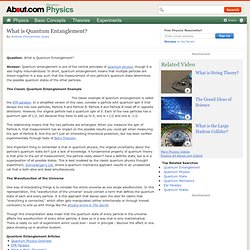

Intrication quantique. Paradoxe EPR. Quantum entanglement. Quantum entanglement is a physical phenomenon that occurs when pairs or groups of particles are generated or interact in ways such that the quantum state of each particle cannot be described independently – instead, a quantum state may be given for the system as a whole.

Such phenomena were the subject of a 1935 paper by Albert Einstein, Boris Podolsky and Nathan Rosen,[1] describing what came to be known as the EPR paradox, and several papers by Erwin Schrödinger shortly thereafter.[2][3] Einstein and others considered such behavior to be impossible, as it violated the local realist view of causality (Einstein referred to it as "spooky action at a distance"),[4] and argued that the accepted formulation of quantum mechanics must therefore be incomplete. History[edit] However, they did not coin the word entanglement, nor did they generalize the special properties of the state they considered.
Concept[edit] Can quantum entanglement be a proof of a 4th spatial dimension. Extra Dimensional Approach of Entanglement. Intrication quantique - Intrication. L'intrication quantique est un phénomène fondamental de la mécanique quantique mis en évidence par Einstein et Schrödinger dans les années 30.

Deux systèmes physiques, comme deux particules, se retrouvent alors dans un état quantique dans lequel ils ne forment plus qu'un seul système dans un certain sens subtil. Toute mesure sur l'un des systèmes affecte l'autre, et ce, quelle que soit la distance les séparant. Avant l'intrication, deux systèmes physiques sans interactions sont dans des états quantiques indépendants mais après l'intrication ces deux états sont en quelque sorte « emmêlés » et il n'est plus possible de décrire ces deux systèmes de façon indépendante.
C'est pourquoi, comme indiqué précédemment, des propriétés de non-localité font leur apparition et la mesure sur l'un des systèmes influence instantanément l'autre système, même à des années-lumière. -il n'y a fondamentalement ni onde ni corpuscule au sens classique dans la nature. H=T(Pi)+V(Qi) Ι Ψ > = ∑ cn Ι an > où Ainsi. [1310.4691] Time from quantum entanglement: an experimental illustration. Extending Einstein's ideas: New kind of quantum entanglement demonstrated. Physicists at the University of Calgary and at the Institute for Quantum Computing in Waterloo have published new research in Nature Physics which builds on the original ideas of Einstein and adds a new ingredient: a third entangled particle. Quantum entanglement is one of the central principles of quantum physics, which is the science of sub-atomic particles. Multiple particles, such as photons, are connected with each other even when they are very far apart and what happens to one particle can have an effect on the other one at the same moment, even though these effects can not be used to send information faster than light.
"This work opens up a rich area of exploration that combines fundamental questions in quantum mechanics and quantum technologies," says Christoph Simon, paper co-author and researcher at the University of Calgary. This research extends the theories of Einstein, seventy-seven years later. [1310.4691] Time from quantum entanglement: an experimental illustration. Quantum Entanglement Explained. Want to stay on top of all the space news?

Follow @universetoday on Twitter Confused by how particles can be in two places at once? Wondering how particles can instantly communicate with each other no matter what the distance? Quantum physics is a field of study that defies common sense at every turn, and quantum entanglement might lead the way in the defying common sense department. Entanglement is the unusual behavior of elementary particles where they become linked so that when something happens to one, something happens to the other; no matter how far apart they are.
This new video from PHD Comics provides a combination of live action and animation to try to explain entanglement. “Not surprisingly, it was really hard to draw this video,” says animator Jorge Cham. A frame from the ‘Quantum Entanglement Animated’ video, via QuantumFrontiers.com. What is entanglement. Entanglement is a term used in quantum theory to describe the way that particles of energy/matter can become correlated to predictably interact with each other regardless of how far apart they are.

Particles, such as photons, electrons, or qubits that have interacted with each other retain a type of connection and can be entangled with each other in pairs, in the process known as correlation. Knowing the spin state of one entangled particle - whether the direction of the spin is up or down - allows one to know that the spin of its mate is in the opposite direction. Even more amazing is the knowledge that, due to the phenomenon of superposition, the measured particle has no single spin direction before being measured, but is simultaneously in both a spin-up and spin-down state. What Is Quantum Entanglement? Question: What is Quantum Entanglement?

Answer: Quantum entanglement is one of the central principles of quantum physics, though it is also highly misunderstood. In short, quantum entanglement means that multiple particles are linked together in a way such that the measurement of one particle's quantum state determines the possible quantum states of the other particles. The Classic Quantum Entanglement Example The classic example of quantum entanglement is called the EPR paradox. In a simplified version of this case, consider a particle with quantum spin 0 that decays into two new particles, Particle A and Particle B. This relationship means that the two particles are entangled. One important thing to remember is that in quantum physics, the original uncertainty about the particle's quantum state isn't just a lack of knowledge.
The Wavefunction of the Universe One way of interpreting things is to consider the entire universe as one single wavefunction.